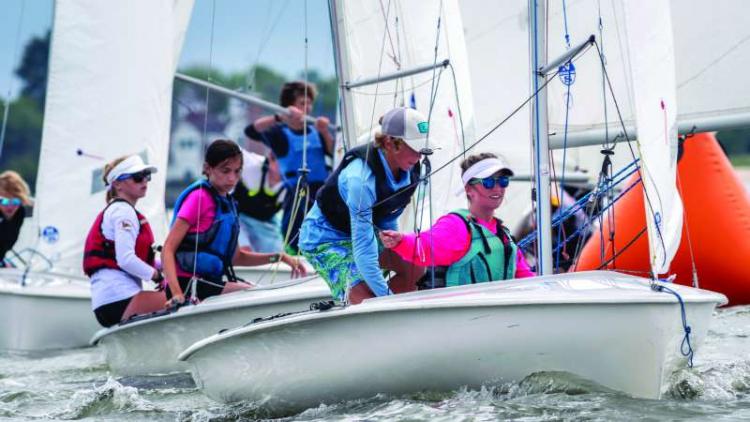Sailboat Racing: Tips To Make Your Mark Roundings as Chaos-Free as Possible
Happy spring! It’s time to dive on into sailboat racing. In the one-design classes and especially dinghies that we focus on here in “Small Boat Scene,” one of the things that’s always an exciting rediscovery after a winter away from racing (except for the folks lucky enough to enjoy time down south or frostbiting) is how everyone seems to converge on the first weather mark all at the same time.
One leg doesn’t give a fleet of boats that go pretty much the same speed upwind much time to spread out. It’s simultaneously joyful and panicky to have 10 boats rounding the weather mark together. There’s a lot going on in there! Here are some tips to help make your experience as chaos-free as possible.

Before the mark
The last third or quarter of the leg, it’s important to do some planning ahead. Where are you sitting in the fleet? If you’re among the leaders, you have more options as there will be fewer boats to maneuver around and fewer wind shadows to consider while going upwind.
Consider how you want to approach the mark. Is there more breeze on one side of the top of the course? Is there less harmful current on one side? Determine which layline you’d prefer to come to the mark on in the absence of other boats. If you had no competitors, you could just go precisely to that layline and march right on in to the weather mark.
But that’s not the case. There’s company. And if you are further back in the fleet, sailing in to the mark right on layline is likely not a great option. You’ll have to weigh your options: Over stand the layline—sailing extra distance, but ensuring you’ll make the mark—or intentionally under-stand the layline by a bit, sailing enough below the traffic jam on the layline to keep your air (sort of) clean, but dealing with the stress of finding a slot to tack up to round the mark at the last (or near to the last) moment.
If you’re toward the front, the distance you would need to over- or under-stand is less than it would be if you are further back.
No matter what you decide, in the last part of the leg, sail as fast as possible. Other folks are not efficient at making decisions and often get distracted; you can gain a valuable boatlength or more by keeping your help speedy. And, identify the location of the next mark so you know what the course angle is coming out of the weather mark. Is there an offset mark? They are not always perfectly set; make sure you know whether it’s a little ease off, or if it may be set significantly up or downwind from where you’d expect it to be.

Approaching the mark
For the last 100 yards or so, if you’re super tight on the layline, consider holding off on any major adjustments you might need to make for the next leg (prepping spinnaker) if crew movements/heel of boat might make you slide below the mark. If there are controls you can reach without moving crew to get you prepped for next leg (even if it’s a short offset), do them: maybe a little ease of vang, ease the cunningham, etc.
Keep the speed going; minimize distraction to the person on the helm if possible (of course, keep an eye out and let them know about any traffic issues). With all the boat traffic converging up there, it can get choppy and the breeze can vary significantly due to wind shadows. Be ready to adjust sails and crew weight. Avoid pinching; you’ll slip sideways!
Make sure the entire team knows what the game plan is for exiting the mark. Will you be sailing high because there’s a juicy puff out there? Soaking well low because there’s a gap behind you? Gybe setting because the mark is waaaaay over there? Say your Plan A out loud.
Rounding the mark
If you’re the driver, give clear communication on when crew can move, set the pole and spinnaker, and make other needed adjustments. If you’re the crew, give the helm what they need to get around the mark without fouling anyone. As you’re heading into the mark, helm should verify the game plan, or let the crew know what the change is (“Shoot, that boat snuck inside us; we can’t gybe set; straight set instead”) so that they can respond.
Departing the mark
Internal to your boat, communicate where the boats behind you are going so that you don’t get stuck in someone’s dirty air right off the bat. Other than that, just go fast for 30 seconds (escape from Alcatraz), and reevaluate to update your plans.
Take a deep breath, you made it around the weather mark!
About the Author: SpinSheet Small Boat columnist for more than a dozen years, Kim Couranz has earned several national and world titles in Laser Radials (ILCA 6) and Snipes. She has also raced J/22s, J/24s, and Ynglings on an international level.
Find another great racing article by Couranz here.




